Imagine some 2000 years ago a Pharaoh was buried in the great pyramids and adorned in gold and riches. Radical wealth disparity in that ancient Egypt, huh?
Not only did the great pharaohs spend eternity under a blanket of gold and jewels, they were also entombed with all kinds of trinkets and even foods! In fact, Archeologists have found honey in these tombs that is easily 2000 years old. The oldest sample has been dated at 3000 years old!
An ingredient like honey basically lasts forever! Of course, it’s not the only ingredient that will last for a very long time. As preppers we see the value in ingredients that have a long shelf life.
If food can sit on your shelves for a lifetime than that means you have food for any and all circumstances. For preppers and those seeking a lifetime of self-reliance and independence, FOOD is going to be the single most important commodity in your life in the 21st century.
Related: What Do I Store in My Pantry As a Prepper?
Best by Confusion
Most people believe that the date on the can of food or the package of food at the supermarket is religion. They believe that food past that date is trash.
These best by dates are part of a very interesting misunderstanding that few people clarify. The industry has used this confusion to sell more food!
If people knew the intent of the best by date, rather than the perceived notion, they would buy less food and hold onto what is in their pantry for much longer.
Best by is a quality date. When a food item is produced in a batch, the company is putting its name and reputation out on the market with that product. That food item will not taste the same way forever. There will come a time when a can of soup starts to taste different because of the time in the can. A packaged baked good will taste different after a length of time passes.
Once the taste is compromised, it is no longer representative of that brand and its reputation. It is no longer at its BEST.
Of course, it can be eaten for a long time past that date. Keep that in mind.
Here are 5 delicious recipes with ingredients that last 100 years:
#1. Rice and Bean Soup
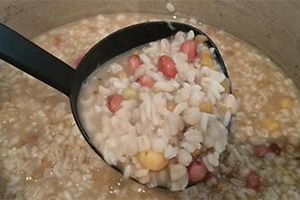 The ingredients you will need are:
The ingredients you will need are:
- 1 Cup of Red Beans
- ¼ Cup of Rice
- 6 Cups of water
- 1 Tsp of Chili Powder, Garlic Powder and Turmeric, each
- 1 Bouillon Cube.
The first thing to do is soak your beans in warm water overnight.
The next day, start by cooking your beans in 6 cups of water and simmer them for about 4 hours or until they are soft. Do not add salt until your beans are soft, or it could prevent them from ever getting tender.
Once the beans have gotten tender, you will add your bouillon cube and spices. Next add your rice and simmer the soup until your rice has cooked through. At this point you can adjust seasoning to your preference with salt and pepper.
#2. Smoked Fish and Dried Potato Cakes
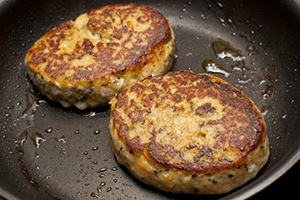 For this second recipe you will need:
For this second recipe you will need:
- 1 Cup of Smoked White Fish
- 2 Cups of Dried Potato Flakes, Dices or Powder
- ¼ Cup of Flour
- ¼ Cup of water
- 1 Egg.
Mix all your ingredients together in a bowl. Form them into patties. Fry on both sides in a cast iron skill with oil. Once they are crispy on both sides, they are ready. Drain excess oil and eat.
Related: 8 Ways to Use Your Rancid Oil for Survival
#3. Red Wheat Berry Cereal
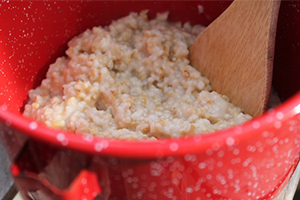 The ingredients needed are:
The ingredients needed are:
- 2 Cups Hard Red Wheat
- 7 Cups Water
- 1 Cup of Oats
- ¼ Cup of Powdered Milk
- 1 Cup Cooked Wheat Berries
- Salt to taste
- Cinnamon.
First, cook the wheat berries for one hour in your 7 cups of water, and add salt to make them tender.
Next cook your cup of oats ’till almost done and add your powdered milk and wheat berries. Stir in some cinnamon to taste and you are ready to serve this breakfast up.
Related: 10 Ingenious Ways to Keep Moths Away From Your Grains
#4. Ramen with Jerky and Egg
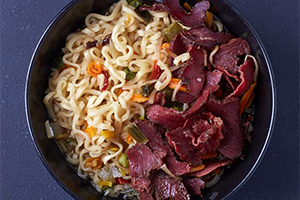 The ingredients you’ll need are:
The ingredients you’ll need are:
- 4 Packs of Beef Ramen
- 1 lb of Beef Jerky
- Fresh or Frozen Soup Vegetables (corn, peas, potatoes)
- 1 egg
- Tbsp of Dashi Powder.
This is a super easy recipe. Make your Ramen by package directions. Add your soup vegetables, dashi and bring back to a simmer. Take it off the heat and stir in your jerky. Fry the egg and add it on top.
#5. Pemmican and Lentils
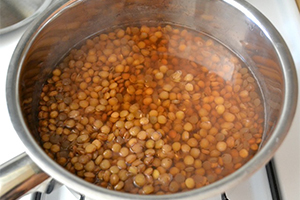 This recipe calls for 6 ingredients only:
This recipe calls for 6 ingredients only:
- 1 Cup of Lentils
- 1-2 lbs of Pemmican
- 2 Cups of Water
- 1 Beef Bouillon Cube
- 1 Tbsp of Curry Powder
- 1 Onion, Diced
Start your onion in a pan with a little bit of oil. Sauté the onion over low heat until it goes translucent. Add your lentils and cook them for a minute or so.
Add your water, curry powder and bouillon cube to the pan. Simmer your lentils until they are soft.
In a separate bowl add your pemmican. Drain your lentils and add them to the bowl. Toss the mix sparingly and serve.
These ingredients that last 100 years or more, should be found in every prepper’s pantry. Which of these ingredients are in your pantry?
You may also like:
 If I Could Only Stockpile 10 Foods
If I Could Only Stockpile 10 Foods
10 Things Cowboys Carried With Them in the Wild West to Survive (Video)
How Long Can You Store Food In The Freezer? (Infographic)
How the Early Pioneers Preserved Food and What They Ate
What Really Happens if You Eat a Bucket of Survival Food When SHTF















No matter what I tell my wife and grandkids about the best by dates on food. If it was best by last month it is gone. that is part of the reason why I do not want them in the pantry. But I may as well be trying to stop the tide from coming in.
Yes, I remember the days of sniff n taste. You knew if it was rank or not. I don’t let my elder kids go through my pantry things either. Or they would chuck the lot out. I’d be like ?? took me ages to convince them that honey never goes off and if it crystallises, you have the real deal. Not glucose honey flavoured stuff.
The smell of real honey is also different from that of syrup or high fructose corn syrup. I suppose if honey has been mixed with HFCP it’s hard to spot for a layman, but pure HFCP lacks something in its aroma that honey has, you’ll know the difference if you smell them side by side.
FYI
#3 has an error in it
I do not see where to add the first ingredient the hard wheat. I read over the recipe and did not find this add in the instructions.
I use to do a lot of canning, not so now. That was when I was on the farm and growing most if not all my produce and meat. I am now eating some of the things I canned 25-30 years ago, and so far, I am still alive. Some may have darkened a little but the favor is there.
What are they? Can you be more specific? Meat, veggies, fish…….?
Do you observe any other differences beside darker color?
Tell you wifevi am consistently eating can of beans, soups, sardines etc. Now, from 2011 and newer, THE TELL TSLE SIGNS NOTVTO EAT ARE : BULGED OR LEAKING CANS, A TINNY TASTE. OTHERWISE I am still here…
I have been eating out of cans from WWII ! My grandmother had a surplus of cans (mashed potatoes, pudding, fruits, and veggies) They are from 1943! Pudding tastes just fine..veggies and fruit were delish too! I am still here!
Most canned goods will last for a long time. I usually take the ones that have acidic foods or a dented can and dehydrate the contents, and store them in a different container with an oxygen packet. That way I am not worried about botulism and other deadly bacteria.
In the Red Wheat Berry Cereal, whats with the 2 cups of hard red wheat AND the1 cup of cooked wheat berries?
Hi Dave, I would guess that you cook the 2 cups of berries and then use 1 cup of cooked berries to mix with all the other ingredients. Then refrigerate the rest of berries for the next day. Just a guess because 2 cups of dry will probably turn into 3 or more of cooked. Peace, Matt.
Bullion cubes, smoked white fish, and eggs do not keep 100 years. Ground flour will not either, but wheat berries will and can be ground into whole wheat flour on demand. The various spices in your recipes, when ground as they commonly are, will have little power after only a few years. A few other of your ingredients (such as beef jerky) may last that long, but it is doubtful.
Freeze dried food should last 25 years. But 100 years is a stretch. To my knowledge, only “the Mormon four” are known to last essentially indefinitely..
There was wheat stored in those pyramids as well. Some was able to sprout.
Perhaps 100 years was a bit overstated. Additionally, if the food you have stored away is 100 years old, how old does that make you?
If you stored the food away 100 years prior, better add lots of water and make it gruel and make sure the meat is cooked until is is mush.
That’s right, some of my teeth may last 100 years but I already see the day coming when I’m gonna have to eat jerky with a hammer and a flat rock. In fact, I quit serving ribs and corn on the cob at dinner parties 20 years ago. Still hanging on to my youthful good looks…
In Esther Dickey’s book she recommends wheat, powdered milk, honey and salt as the 4 basic ingredients for a survival pantry. The book is titled Passport To Survival, mine was printed in 1969.
The recipes are basic but will keep you alive. She adds a further 40 more items which require rotation: peanut butter, tomato juice, vitamin pills, soybeans, lentils, dried green peas, millet, yellow corn, blackstrap molasses, brown rice, dry yeast, vegetable powders. Then in the 1-3yr category is dried fruit, vegetable oil, evaporated milk, raisins, fermented string beans. 3-5yrs canned meat, figs, rye, rice polishings, sauerkraut, canned tomatoes. Then a list of ‘nice to have’ items.
Personally the canned tomatoes don’t last that long but I can’t buy them without a ringpull lid which I find those type cans don’t last that long. And while the brown rice is more nutritious I store white for longevity. Not sure what rice polishings are. Figs also don’t last that long but that is more because they are so darned tasty they get eaten long before they need using up. A pity I can only pick them once a year in season.
Obviously dietary requirements for a person with allergies or babies would need to look at alternatives but maybe it’s a good base to start with and a garden can always add variety.
Problem with wheat today is it is not the wheat of years past. much less that of the Pharaoh’s time. Do some research.
So what do you suggest? I’ve done some research but can always do more as time permits 🙂 How do our current wheats differ from the old types other than what I’ve mentioned.
Not sure how it works in your area but here R&D into wheat breeding is most often directed towards improving what the customer wants so wheat breeders may focus on gluten content or free threshing or protein levels which in turn changes the varieties we have available to purchase and grow.
We have no control over that and since wheat is a global commodity, what we grow here in AU is often dictated by what is wanted in Japan, Korea or the EU, not necessarily what is wanted on the domestic market or by the grower.
I would love to have had the foresight to keep some of the older varieties but I guess they are stored in some lab for breeding purposes these days. I am also skeptical about the pharaoh’s wheat actually germinating and think it is more likely that they were able to determine that some small pockets of domestic wheat grown in that area had a very similar dna profile to the old wheat and had been grown over the centuries with little or no crossing resulting in a type almost true to the original. Isolation of crops can do that or course. I know that wild wheat or very old varieties are still used in today’s breeding cycles to incorporate things like cold or heat tolerance, salinity or disease tolerance that may be lacking in a modern variety. Unfortunately for me most if not all of those are sourced overseas in the fertile crescent and I’m not able to import them.
Apologies, the wheat I wrote about was in a different post replying to Left Coast Chuck.
I mentioned Emmer(Farro), Spelt, Einkorn and Khorasan/Kamut as being ancient hulled wheat varieties whereas our modern wheats are free threshing, along with differences in protein, yields etc.
The wheat we currently grow was released 23yrs ago which makes it a fairly new wheat but quite old as a commercial variety.
I don’t think spices and bouillon cubes will last 100 years. Rice and beans is OK, but without those other ingredients it is basically inedible for more than a week or a couple weeks maybe.
It should be mentioned that as dry beans age, they become harder and harder, making long, long term storage as dry not a good idea. At some point, you will not be able to rehydrate them at all. I plan to can a bit, cook and dehydrate, and freeze dry beans my beans as well as have the dry beans available. (I’m not certain if lentils will follow these rules or not).
Also, most people will not just have dashi powder hanging around (I had to look it up). I also looked up homemade, which could be kept a long time.
You CAN make your own bouillon cubes, I have several recipes but I like a good vegetable broth seasoning (homemade, and add in freeze dried beef or chicken that has been powdered: these WILL last a long time…maybe not 100 years.)Another recipe is for freezer cubes; making homemade bone broth, leaving a small amount of the vegetables used in making it, blending it all up, then freezing as cubes. I also plan to freeze dry this and powder it.
The eggs someone mentioned: you can preserve eggs several ways, some that don’t require refrigeration or freezers, but also, you can get freeze dried and also, you could use egg replacers, but those wouldn’t have the same nutritional value. (some more, some less) So, presering eggs IS possible to use here as mentioned, and if you have your own chickens, well…there you go!
I’m not sure how long smoked fish will last, but I think if properly packaged,quite awhile. I have some smoked salmon (yes I refrigerate it) that I’ve had around for a few years that is still good. I imagine if I had vacuum packed it in smaller amounts, it would still be good out of refrigeration a long time…
So, with a little work you can make your own and preserve it, making this post pretty accurate.
Nice post, and for the most part quite do-able…(IF I wasn’t T2Diabetic, which makes a lot of prepper foods not a good call for my health! LOL! (I am still stocking them, though!)